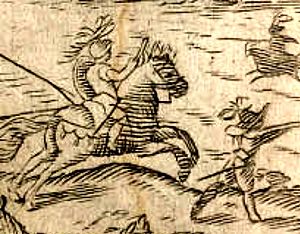Battle of Lagunillas facts for kids
Quick facts for kids Battle of Lagunillas |
|||||||
|---|---|---|---|---|---|---|---|
| Part of Arauco War | |||||||
 Battle of Lagunillas |
|||||||
|
|||||||
| Belligerents | |||||||
| Commanders and leaders | |||||||
| Strength | |||||||
| 530 Spanish Cavalry, 200 arquebusiers, 5 artillery pieces, 4,000 Indian auxiliaries | 8,000 - 12,000 Mapuche | ||||||
| Casualties and losses | |||||||
| 2 Spaniards killed and many seriously wounded | 300 killed, 150 captured | ||||||
The Battle of Lagunillas was an important fight during the Arauco War. It happened on November 8, 1557. The battle was between the army of García Hurtado de Mendoza and the Mapuche army. It took place near some small lakes, about a league south of the Bio-Bio River.
Contents
How the Battle Started
Mapuche Prepare for Defense
The Mapuche people knew that Mendoza's army was planning to enter their land. So, they got ready to defend themselves. They gathered their forces in three main spots. One group was at a strong fort called a pucará on a hill named Andalicán. This fort was south of Concepcion and protected the path to Arauco. Other Mapuche forces gathered near Millarapue and Tucapel.
Spanish Army Crosses the River
Mendoza's army was well-prepared. They left Concepcion on October 29 to begin their fight against the Mapuche. They marched south to the mouth of the Bio-Bio River. There, they set up camp. Mendoza sent a small group of soldiers upstream to cut wood. This group was supposed to build rafts to cross the river.
This was a trick to make the Mapuche think the main crossing would happen there. But Mendoza planned to cross the river using his fleet's boats. He also used special rafts to quickly move his many horses. His trick worked, and his entire army crossed the river without any problems.
The Battle of Lagunillas
Scouting and Ambush
After crossing the river, Mendoza's army moved further south. They stopped near some small, shallow lakes at the base of the wooded mountains of Araucanía. Mendoza sent a small group of cavalry, led by Captain Reinoso, to scout the area. They needed to find the best path for the next day's march.
When Reinoso's group saw the Mapuche forces at Andalicán, they were attacked. Reinoso's soldiers slowly retreated. They tried to hold off the Mapuche while sending a message to Mendoza. The message warned that the Mapuche were moving towards the main army.
At the same time, two Spanish soldiers left their camp without permission. They went into the nearby woods to pick some fruit. There, they found a large group of Mapuche waiting to ambush the Spanish army. One Spanish soldier was killed, but the other managed to escape. He quickly returned to camp to warn everyone about the hidden enemy.
The Fight Begins
When Mendoza heard that the Mapuche were close, he sent more soldiers to help Captain Reinoso. Fifty cavalry and twenty arquebusiers (soldiers with early firearms) joined Reinoso. With these reinforcements, Reinoso and another captain, Rodrigo de Quiroga, slowed down the Mapuche. They fought through marshes and ponds.
Because of the warning about the ambush, Mendoza quickly got his army ready for battle. They fought off the first Mapuche attack. Soon, Reinoso and Quiroga returned with their group, with the Mapuche from Andalicán right behind them. A big battle then began.
Spanish Victory
The Spanish army was outnumbered, but their arquebusiers and artillery were very effective. They broke up the Mapuche attacks. The Spanish cavalry then used this confusion to push the Mapuche back. The Mapuche tried to find safety in a marsh, hoping the horses couldn't follow.
However, the Spanish foot soldiers followed them into the marsh. The Mapuche fought hard, but eventually, they had to run away. They fled into the wooded hills behind the marsh. The Spanish soldiers chased them carefully, watching out for any new ambushes. They returned to camp later that afternoon with prisoners.
Two Spanish soldiers were killed in the battle, and many were hurt. The Mapuche lost about 300 warriors, and 150 were captured. One of the captured Mapuche leaders was Galvarino.
Aftermath of the Battle
Punishment and Warning
The captured Mapuche prisoners were put on trial. Many were severely punished as a warning to others. Some prisoners, like Galvarino, received very harsh punishments. Galvarino and the others were then set free.
Mendoza sent Galvarino to tell the Mapuche leader, Caupolican, about the strength of the Spanish army. Mendoza hoped this would scare Caupolican into giving up without another fight.
Spanish Advance
The next day, Mendoza's army moved forward. They captured the abandoned Mapuche fort on Andalicán. The day after that, the army continued its advance. They took control of the heights of Marihueñu, which were not strongly defended. This opened the way for the Spanish to enter the province of Arauco.
See also
 In Spanish: Batalla de Lagunillas para niños
In Spanish: Batalla de Lagunillas para niños

